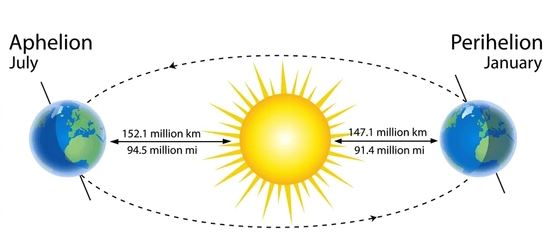From UPSC perspective, the following things are important :
Prelims level: What is Aphelion?
Mains level: Does aphelion affect temperatures on Earth?

Why in the News?
Early on July 5, the Earth reached aphelion, its farthest distance from the sun in our year-long journey around our nearest star.
What is Aphelion?
|
How far is the Earth from the Sun at aphelion?
- At aphelion, which occurs around July 4th– 5th each year, the Earth is approximately 152.1 million kilometers (about 94.5 million miles) away from the Sun.
- This distance is about 3.3% greater than its average distance from the Sun, known as its semi-major axis, which is about 147.1 million kilometers.
Does aphelion affect temperatures on Earth?
- Aphelion has a slight effect on temperatures on Earth, but its impact is minimal compared to other factors such as axial tilt and atmospheric circulation patterns.
- Despite being farther from the Sun during aphelion, the Earth’s tilt towards the Sun during the northern hemisphere’s summer results in warmer temperatures for that region.
- This phenomenon is primarily responsible for the seasons on Earth.
What would happen if there were no aphelion?
- If Earth’s orbit were perfectly circular, without aphelion or perihelion (the closest point to the Sun), the distance between Earth and the Sun would remain constant throughout the year.
- This scenario would result in less variation in seasonal temperatures between the northern and southern hemispheres.
- The distinct seasons that we experience today, which are essential for ecological diversity and agricultural cycles, would be significantly altered.
PYQ:[2013] Variations in the length of daytime and night time from season to season are due to- (a) The earth’s rotation on its axis (b) The earth’s revolution round the sun in an elliptical manner (c) Latitudinal position of the place (d) Revolution of the earth on a tilted axis |
Get an IAS/IPS ranker as your 1: 1 personal mentor for UPSC 2024
